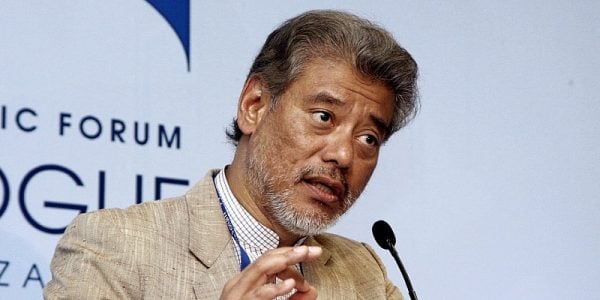
Natural flows do not respect national boundaries. The atmosphere and oceans cross international borders with little difficulty, as greenhouse gases (GHGs) and other fluids, including pollutants, easily traverse frontiers.
Yet, in multilateral fora, strategies to address climate change and its effects remain largely national. GHG emissions – typically measured as carbon dioxide equivalents – are the main bases for assessing national climate action commitments.
Assessing national responsibility
Jayati Ghosh, Shouvik Chakraborty and Debamanyu Das have critically considered how national climate responsibilities are assessed. The standard method – used by the UN Framework Convention on Climate Change (UNFCCC) – measures GHG emissions by activities within national boundaries.
This approach attributes GHG emissions to the country where goods are produced. Such carbon accounting focuses blame for global warming on newly industrializing economies. But it ignores who consumes the goods and where, besides diverting attention from those most responsible for historical emissions.
Thus, attention has focused on big national emitters. China, India, Brazil, Russia, South Africa and other large developing economies – especially the ‘late industrializers’ – have become the new climate villains.
China, the United States and India are now the world’s three largest GHG emitters in absolute terms, accounting for over half the total. With more rapid growth in recent decades, China and India have greatly increased emissions.
Undoubtedly, some developing countries have seen rapid GHG emission increases, especially during high growth episodes. In the first two decades of this century, such emissions rose over 3-fold in China, 2.7 times in India, and 4.7-fold in Indonesia.
Meanwhile, most rich economies have seen smaller increases, even declines in emissions, as they ‘outsource’ labour- and energy-intensive activities to the global South. Thus, over the same period, production emissions fell by 12% in the US and Japan, and by nearly 22% in Germany.
Obscuring inequalities
Only comparing total national emissions is not just one-sided, but also misleading, as countries have very different populations, economic outputs and structures.
But determining responsibility for global warming fairly is necessary to ensure equitable burden sharing for adequate climate action. Most climate change negotiations and discussions typically refer to aggregate national emissions and income measures, rather than per capita levels.
But such framing obscures the underlying inequalities involved. A per capita view comparing average GHG emissions offers a more nuanced, albeit understated perspective on the global disparities involved.
Thus, in spite of recent reductions, rich economies are still the greatest GHG emitters per capita. The US and Australia spew eight times more per head than developing countries like India, Indonesia and Brazil.
Despite its recent emission increases, even China emits less than half US per capita levels. Meanwhile, its annual emissions growth fell from 9.3% in 2002 to 0.6% in 2012. Even The Economist acknowledged China’s per capita emissions in 2019 were comparable to industrializing Western nations in 1885!
Several developments have contributed to recent reductions in rich nations’ emissions. Richer countries can better afford ‘climate-friendly’ improvements, by switching energy sources away from the most harmful fossil fuels to less GHG-emitting options such as natural gas, nuclear and renewables.
Changes in international trade and investment with ‘globalization’ have seen many rich countries shift GHG-intensive production to developing countries.
Thus, rich economies have ‘exported’ production of – and responsibility for – GHG emissions for what they consume. Instead, developed countries make more from ‘high value’ services, many related to finance, requiring far less energy.
Export emissions, shift blame
Thus, rich countries have effectively adopted then World Bank chief economist Larry Summers’ proposal to export toxic waste to the poorest countries where the ‘opportunity cost’ of human life was presumed to be lowest!
His original proposal has since become a development strategy for the age of globalization! Thus, polluting industries – including GHG-emitting production processes – have been relocated – together with labor-intensive industries – to the global South.
Although kept out of the final published version of the Intergovernmental Panel on Climate Change (IPCC) report, over 40% of developing country GHG emissions were due to export production for developed countries.
Such ‘emission exports’ by rich OECD (Organization for Economic Co-operation and Development) countries increased rapidly from 2002, after China joined the World Trade Organisation (WTO). These peaked at 2,278 million metric tonnes in 2006, i.e., 17% of emissions from production, before falling to 1,577 million metric tonnes.
For the OECD, the ‘carbon balance’ is determined by deducting the carbon dioxide equivalent of GHG emissions for imports from those for production, including exports. Annual growth of GHG discharges from making exports was 4.3% faster than for all production emissions.
Thus, the US had eight times more per capita GHG production emissions than India’s in 2019. US per capita emissions were more than thrice China’s, although the world’s most populous country still emits more than any other nation.
With high GHG-emitting products increasingly made in developing countries, rich countries have effectively ‘exported’ their emissions. Consuming such imports, rich economies are still responsible for related GHG emissions.
Change is in the air
Industries emitting carbon have been ‘exported’ – relocated abroad – for their products to be imported for consumption. But the UNFCCC approach to assigning GHG emissions responsibility focuses only on production, ignoring consumption of such imports.
Thus, if responsibility for GHG emissions is also due to consumption, per capita differences between the global North and South are even greater.
In contrast, the OECD wants to distribute international corporate income tax revenue according to consumption, not production. Thus, contradictory criteria are used, as convenient, to favor rich economies, shaping both tax and climate discourses and rules.
While domestic investments in China have become much ‘greener’, foreign direct investment by companies from there are developing coal mines and coal-fired power plants abroad, e.g., in Indonesia and Vietnam.
If not checked, such FDI will put other developing countries on the worst fossil fuel energy pathway, historically emulating the rich economies of the global North. A Global Green New Deal would instead enable a ‘big push’ to ‘front-load’ investments in renewable energy.
This should enable adequate financing of much more equitable development while ensuring sustainability. Such an approach would not only address national-level inequalities, but also international disparities.
China now produces over 70% of photovoltaic solar panels annually, but is effectively blocked from exporting them abroad. In a more cooperative world, developing countries’ lower-cost – more affordable – production of the means to generate renewable energy would be encouraged.
Instead, higher energy costs now – due to supply disruptions following the Ukraine war and Western sanctions – are being used by rich countries to retreat further from their inadequate, modest commitments to decelerate global warming.
This retreat is putting the world at greater risk. Already, the international community is being urged to abandon the maximum allowable temperature increase above pre-industrial levels, thus further extending and deepening already unjust North-South relations.
But change is in the air. Investing in and subsidizing renewable energy technologies in developing countries wanting to electrify, can enable them to develop while mitigating global warming.
Related IPS articles:
- COP27 Fiddling as World Warms
- Climate Hypocrisy Ensures Global Warming
- Climate Inaction, Injustice Worsened by Finance Fiasco
- Carbon Tax Over-Rated
- Will Glasgow Fix Broken Climate Finance Promises?
This article was originally published on KSJomo.org.
(Hezri A Adnan is adjunct professor at the Faculty of Sciences, University of Malaya, Kuala Lumpur; Jomo Kwame Sundaram was an economics professor and United Nations Assistant Secretary-General for Economic Development.)
ADVERTISEMENT
ADVERTISEMENT



































